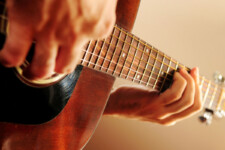Can You Play Electric Guitar Without a Pick? (Hot Tips!)
Playing electric guitar without a pick opens up some whole new ways to play your instrument.
When you first start learning to play without a pick it can feel like a bit of a step back in your skill level. This is because fingerpicking on your guitar requires you to develop a whole new muscle memory before you master it.
Learning to control the fingers on your strumming hand takes time and practice, but learning how to play without a pick will make you a better guitarist.
Playing without a pick can help you find new ways to play harmonies and melodies on your guitar.

Is Playing Electric Guitar With A Pick Better?
Playing guitar without a pick requires you to use different techniques for play. This doesn’t mean it’s bad for your technique though. If anything it’s going to put you better in touch with your guitar by giving you new insight into why chords sound the way they do.
Learning to play with a pick AND with your fingers will make you a more diverse player. But only if you learn both ways to play correctly!
It can be tempting to pick up a guitar without a pick and try and play it the same way you would usually play it. Using your fingernails as if they were your pick is fine for playing chords, but if you’re doing lead work, it’s important to learn how to pick different strings with different fingers.
Developing your fingerpicking technique alongside playing with a pick will help you get the most out of your guitar and prepare you for a variety of styles and sounds.
1. Pros & Cons for Developing Accuracy
Developing your proficiency with fingerpicking can do wonders for your accuracy. Fingerpicking, if done correctly will give you far more control over what strings you’re playing.
Fingerpicking allows you to play multiple notes at once, even if they’re multiple strings apart. For example, you can play a note on the highest E string and the lowest E string at the same time. This is almost impossible to do when playing with a pick.
This technique also opens up the possibility of playing two different parts at once! You can finger the lower notes to create bass lines and harmonies while using the higher notes to develop an overarching melody.
This of course requires skill, and practicing this technique will teach you fingers how to think independently from each other. If you can start to get the hang of this your accuracy will go through the roof!
Getting this style of playing to sound smooth is one of the challenges of playing without a pick.
Because each string is being plucked by a different finger, the volume of each string can sound different. This makes your playing sound uneven. It takes time to get your fingers plucking your guitar’s strings with an even amount of force.
It can be difficult at first but it’s not impossible, like anything to do with guitars it just takes practice.
2. Pros & Cons for Developing Speed
Developing speed with a fingerpicking style can also be a challenge. You’re almost guaranteed to lose a lot of your speed when you first get started.
Because your fingers aren’t used to plucking each string individually you will likely find they will fall over each other as you play; making you play the wrong string, or miss them entirely.
This hurdle in your journey to becoming a fingerpicking master is remedied by developing your muscle memory.
By the time you’re thinking about learning to fingerpick, you’ve probably become quite comfortable playing with a pick. Now, remember when you used to mess up where to put your fingers for chords and notes… You got better at it because your fingers took time to develop their muscle memory.
Once you had that muscle memory you stopped making a lot of those mistakes. Now your strumming hand has to go through that same process.
This is unfortunately the most time-consuming part of learning to play without a pick, but a worthwhile one. Once you’ve got that muscle memory fingerpicking can help you play more complex progressions faster than you’d be able to than with a pick.
What Techniques Can You Use to Play Electric Without a Pick?
To play electric guitar without a pick you first need to understand the relationship between your strings and your fingers. Whereas a pick you grip with your thumb and index finger; to play without one requires you to use all of them!
The most popular way to play guitar without a pick is to use your thumb to play the lower notes and your index, middle, and ring fingers to play the rest.
The order of your finger to achieve this technique will go as follows:
- Thumb: Play notes on the 3 lowest strings (E, A, and D)
- Index Finger: Play notes on the G string
- Middle Finger: Play notes on the B string
- Ring Finger: Play notes on the E string
This technique is for more melodic music. A great example of this would be in the song “These Days” by Nico.
Some Blues players like John Mayer use a 3-finger picking style (thumb and first two fingers) that can give a different melodic sound compared to using thumb and three fingers. This technique may be a little easier to learn since you use less fingers, and suits some styles well.
String skipping is another technique you can use when playing without a pick.
- String skipping is when you play 2 notes that are separated at the same time.
- This is done by using your thumb to play the lowest note of the pair and your index finger to play the higher note.
This allows you to accent your bass notes and give them more texture and dynamics. A great example of this technique can be found in the song “Back to the Old House’ by The Smiths.
Another way you can play without a pick is tapping, and this technique has become extremely popular ever since Eddie Van Halen made it famous in Van Halen’s ‘Eruption’.
What Does Playing Electric Guitar Without a Pick do For Tone?
Playing an electric guitar without a pick doesn’t change the tone of the guitar as much as it does when playing an acoustic but it’s still a noticeable difference.
Picking with your fingers gives your guitar a more natural sound. Using a plastic pick on metal guitar strings creates a lot of force. Your fingers on the other hand are softer and cause the strings to vibrate in a different way that’s less harsh.
Using your fingers will make the tone sound warmer and less intense. Whereas using a pick makes your tone sharper and more aggressive.
The volume difference is a big factor too. If you don’t use a pick your guitar is going to sound noticeably quieter.
Guitar picks are made of far stronger stuff than your fingers are. This also means they’re capable of hitting the strings harder. So don’t go trying to play any heavy metal with just your bare fingers.
Is Playing Electric Without a Pick Good for Blues?
Playing without a pick is the preference for many blues players in the professional music world. The reason Blues players chose to not use a pick is because of the versatility and sensitivity it offers.
Playing Blues without a pick presents many benefits to playing Blues. Being a very emotive style of music means blues players need to make use of the dynamics of their guitars. Fingerpicking allows a Blues player to play both softly and loudly at the same time.
The more natural tone of fingerpicking is also a benefit to playing Blues. This more natural sound is a lot warmer than playing with a pick, (that can often sound more artificial). Most people tend to believe this warmer tone suits Blues better.
The ability to play multiple strings across the fretboard at the same time also helps with Blues. This technique gives you freedom of movement around the fretboard making it easier to play the accents and arpeggios used in Blues music.
Can You Use Your Fingernails to Sound Like a Pick?
Yes you can! If you want to learn how to fingerpick but want the option to make your guitar twang like your using a pick then there is a simple solution…
Let your fingernails grow out!
While some people look at long fingernails as a sign of bad hygiene, guitarists see it as the sign of a dedicated player. Guitarists that want the volume and tone of a pick and the accuracy and dynamics of fingerstyle playing will grow their fingernails on their picking hand out to do just that.
Unlike the tips of your fingers, your fingernails are sturdy like a pick and the tone you get from them is almost identical.
If living with long fingernails isn’t ideal there are other ways to get that pick sound with your fingers.
Over time your guitar playing will make your fingers tougher. This happens because your fingers get damaged and healed over and over again as you play. This eventually leads to the formation of calluses on your fingers that let you play harder without it hurting.
Most guitarists will have toughened up their fingers on their non-dominant hand from playing chords and melodies but not on their strumming hand. As you practice fingerpicking these fingers will also toughen up, letting you pluck your strings harder resulting in a sound closer to a pick.
Some Cheats to Harden Your Fingertips Quickly!
There are a couple of ways to harden your fingertips faster than just playing alone, they are a bit of a cheat, but good ones!
Putting a drop of super glue on the ends of each of your fingers is an unorthodox way some guitars use to produce a punchier tone without using a pick.
Doing this replicates the toughness of weathered fingers without the months of pain.
And don’t worry the glue will fall off overnight… most of the time.
Another cheat for toughening up your fingertips is to dab a little denatured alcohol (also known as methylated spirit or wood spirit in some countries) on them daily until calluses develop.
You could also use rubbing alcohol (surgical spirit) the same way.
The alcohol dries the skin, causing it to harden.
Warning: denatured and rubbing alcohol should not be ingested. If someone does consume these substances please seek immediate medical attention. Store it out of reach of children as it is highly flammable and toxic.




